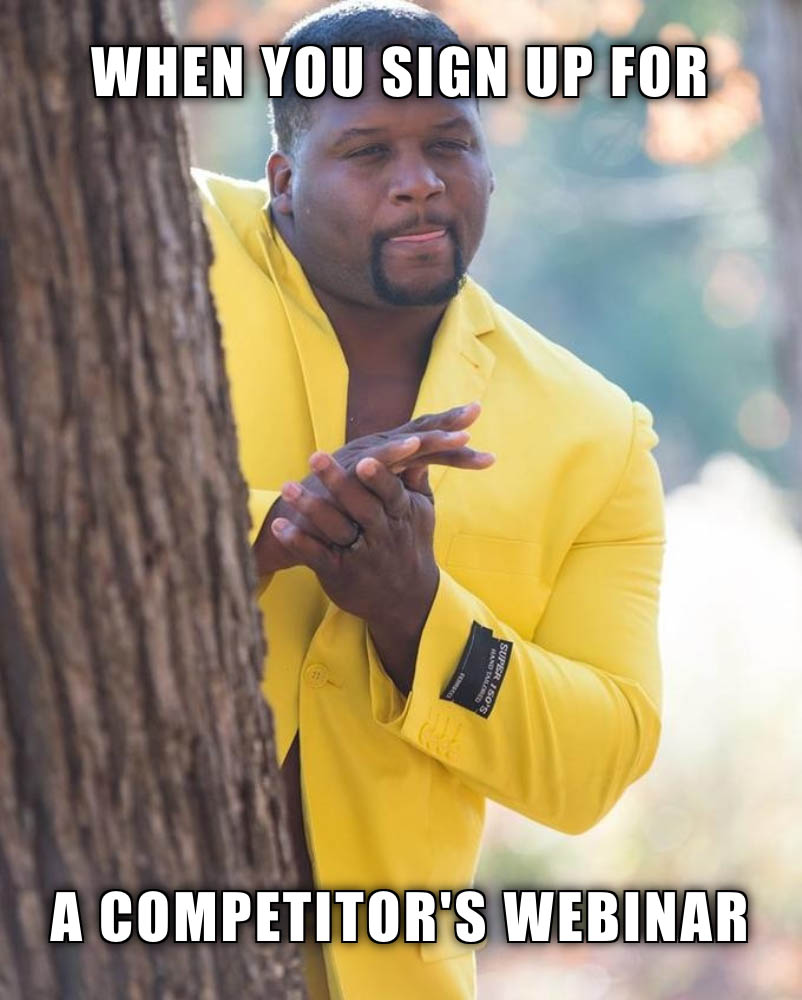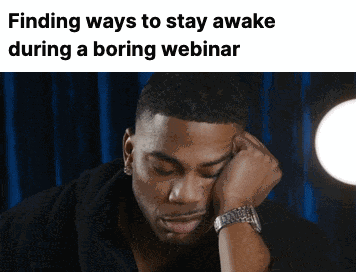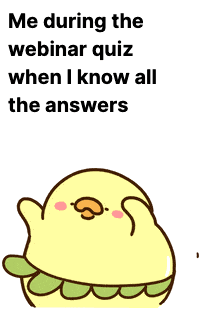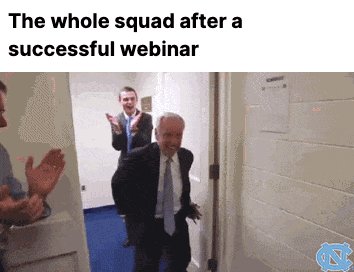TL;DR: Plan well, know your audience, and use good tech. Promote beforehand, engage during, and follow up after.
Planning webinars might be a common part of your content marketing strategy.
But pulling off a successful webinar or virtual event requires a solid game plan to ensure participants have a good time, return for future webinars, and buy whatever you’re selling.
Let’s dive into the nitty-gritty of planning a successful webinar.
Section 1: Pre-planning phase
Market research
First off, know who you’re talking to. I can’t stress enough how important it is to identify your target audience.
Look at demographics, interests, and what kinds of problems your webinar attendees might be looking to solve.
Then, research your competitors. Take a look at the webinars they’re hosting.
- What topics are they covering?
- How are they engaging their audience?
- What could they have improved?
Attend their webinars, take notes, and identify gaps that you can fill.
You can learn a lot from what others are doing, both the good and the bad.

Objective setting
Now that you know who you’re talking to, let’s talk about what you want to achieve.
Are you looking to:
- Become an industry thought leader?
- Build general brand awareness?
- Generate leads?
- Drive sales?
Your objectives will shape everything that comes next — from the content you create, to the interactive elements you include, and how you promote your webinar series.
Be clear about them from the get-go.
Budget allocation
Hosting a webinar isn’t necessarily cheap. There are costs involved, some obvious and some hidden.
You’ll need a reliable webinar platform, and the best features on those aren’t usually free.
Then there’s the promotional aspect. Are you considering running some LinkedIn ads or maybe doing a bit of influencer marketing?
If you’re bringing in an industry expert as a guest speaker, there might be fees involved.
Map out your expenses and decide what you’re willing to invest to make your webinar program a hit.
Having a budget will keep you grounded and help you make smart decisions as you plan your webinar.
Section 2: Content creation
Topic selection
The webinar topic should be relevant to the needs and interests of your target audience, but also something you can speak on with authority.
The best topics often address a specific problem your target audience is facing and offer actionable solutions.
Agenda setting
You wouldn’t go on a road trip without a map, and you shouldn’t host a webinar without an agenda.
This is your roadmap for the event, outlining what you’ll cover and when.
In your webinar script, start with a brief introduction to set the stage, then dive into the core content.
And always, always allocate time for a Q&A session at the end.
Event attendees love to ask questions, and this is your chance to engage with them directly.
Speaker selection
Who’s going to be your webinar host? If you’re an expert on the topic, it might be you.
But sometimes, bringing in an external speaker can add a layer of credibility, draw in a wider audience, and increase audience engagement.
Whether it’s someone from within your organization or an industry expert, make sure your webinar presenters aren’t just knowledgeable but also engaging.
A monotonous webinar speaker can kill even the most interesting topic.

Slide design
Visuals matter. Your slides should complement your words, not replace them.
Keep text to a minimum and let images, graphs, customer stories, and other visual elements do the talking.
But don’t go overboard with flashy animations or complicated designs.
Keep it simple and clean, so your audience can focus on what you’re saying.
Section 3: Technical setup
Platform choice
Choosing the right platform for your webinar is crucial.
You need something that’s reliable, user-friendly, and comes with the features you need.
Back when I was hosting my first webinar series, I made the mistake of going for a platform just because it was cheap.
Big mistake.
The audio lagged, the video quality was poor, and let’s not even talk about the user interface.

So, compare features, read reviews, and if possible, take a few platforms for a test drive before making a decision.
Equipment check
You don’t need a Hollywood studio setup, but you do need decent equipment.
I remember a time when I used a built-in laptop microphone for a webinar. The audio was so bad that it distracted from the content.
Invest in a good quality microphone, a stable camera, and proper lighting.
Run multiple tests to make sure everything is working as it should.
Trust me, the last thing you want is a technical glitch in the middle of your webinar.
Rehearsal
Never underestimate the power of a good rehearsal.
It’s not just about practicing what you’re going to say; it’s about making sure all the technical elements work together seamlessly.
I once did a webinar where I skipped the rehearsal, thinking I had it all under control.
Reader, I didn’t.
The slides didn’t transition smoothly, and I fumbled through the entire presentation.
So do at least one full run-through of your webinar presentation, preferably at the same time of day as your actual webinar to account for any potential internet speed variations.
Section 4: Promoting your webinar
Email campaigns
Email is a tried-and-true method for getting the word out about your upcoming webinar.
But it’s not as simple as sending a mass email and hoping for the best.
I once sent out a last-minute email blast for a webinar registration, and the turnout was dismal.
It turns out it was audit time for most of the companies we’d invited.
Most of them were busy with internal audits and couldn’t attend. Our webinar attendance numbers were disappointing.

Timing is everything.
Start with an invitation email well in advance, followed by reminder emails as the date approaches.
Segment your email list to send targeted messages, and don’t forget to personalize.
A little effort here can go a long way toward boosting attendance.
Social media
Social media is your best friend when it comes to creating buzz. But it’s not just about posting; it’s also about engaging.
I used to just post links to webinars on Twitter and Facebook and wonder why no one was signing up.
Then I started using polls, interactive posts, and even short teaser videos. The engagement skyrocketed.

So, tailor your approach for each platform, use relevant hashtags, and consider scheduling posts to keep the momentum going.
Partnerships
Collaborating with other brands or influencers can give your webinar that extra push.
I once partnered with a well-known industry expert for a webinar, and the sign-ups doubled overnight.
Their endorsement lent credibility and attracted a whole new set of audience members I wouldn’t have reached otherwise.
Look for potential partners who share your target audience but aren’t direct competitors. It’s a win-win for both parties.
Section 5: During the webinar
Registration and check-in
First impressions matter, and the registration process is often the first interaction attendees have with your webinar. Make it smooth and straightforward.
I once attended a webinar where the multiple-field registration form was so complicated I almost gave up.
Don’t let that be you.
Use a simple sign-up form, and consider sending a confirmation email with a calendar invite to make it easy for people to remember.
Engagement strategies
You’ve got your audience in, now you need to keep them engaged.
Polls, quizzes, and live chats are excellent tools for this.
During one of my webinars, I introduced a live quiz halfway through, and the level of engagement was through the roof.
It not only made the session interactive but also helped me gauge the audience’s understanding of the topic in real-time.

Recording and archiving
Always, always record your webinar.
Not only does it serve as a valuable resource you can offer to attendees later, but it also allows you to reach people who couldn’t attend the live session.
I’ve found that offering the recording as an on-demand resource can almost double the reach of the webinar.
Section 6: After the webinar
Follow-up emails
The webinar presentation may be over, but your work isn’t.
Send out a thank-you email to all attendees and include a link to the webinar recording.
I’ve found that this simple gesture can go a long way toward building lasting relationships.
Data analysis
You’ve collected a lot of data from the registration forms, polls, and your attendees’ behavior. Now’s the time to sift through it to improve future webinars.
After a live webinar I did recently, I realized that webinar attendance dropped off after the first 30 minutes.
This was a wake-up call to make my content more engaging right from the start.
Repurposing content
Don’t let your hard work go to waste. Turn your webinar recording into blog posts, infographics, or even a podcast episode.
Doing so can extend your brand awareness from the live event, even if initial webinar attendance was low.
I once turned a recorded webinar into a series of blog posts, and it attracted a whole new audience via organic search.

Summary
To summarize these webinar best practices:
- Know your audience and what you want to achieve.
- Select the right webinar format for your needs.
- Set a budget for things like webinar software and ads.
- Pick a topic that matters to your viewers and plan out what you’ll talk about.
- Test your tech setup and practice beforehand.
- Use emails and social media to get people to join.
- Keep them interested during the event and record it.
- After, send thank-you emails and look at what worked or didn’t.
- Use your webinar content in other ways like blogs or videos.
And that’s your comprehensive guide to planning, executing, and leveraging a successful webinar strategy.
Get the webinar checklist
Planning an upcoming webinar for a product launch?
We’ve put together a webinar checklist with tips to make your live webinar a success.
Grab the webinar planning template here.
And reach out if you need help with your webinar marketing strategy.





